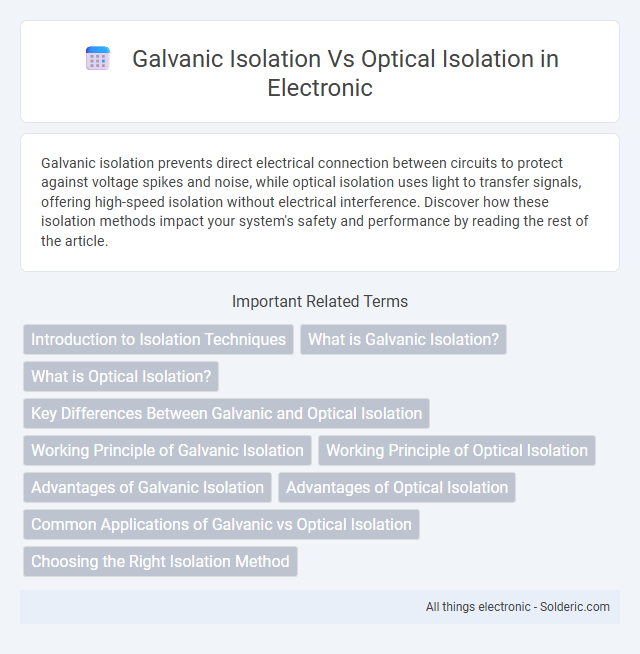Galvanic isolation prevents direct electrical connection between circuits to protect against voltage spikes and noise, while optical isolation uses light to transfer signals, offering high-speed isolation without electrical interference. Discover how these isolation methods impact your system's safety and performance by reading the rest of the article.
Comparison Table
| Feature | Galvanic Isolation | Optical Isolation |
|---|---|---|
| Definition | Electrical isolation method using transformers or capacitors to prevent current flow. | Isolation using light signals transmitted through an optocoupler or LED-photodiode pair. |
| Isolation Medium | Magnetic or capacitive coupling. | Optical (light) transmission. |
| Typical Components | Transformers, capacitors, relays. | LEDs, photodiodes, phototransistors. |
| Signal Types | AC and DC signals depending on components. | Digital signals, pulses. |
| Isolation Voltage | Up to several kV (kilovolts), depending on device. | Up to several kV, varies with optocoupler rating. |
| Speed | Generally slower due to inductive or capacitive nature. | High-speed signal transmission possible. |
| Size | Typically larger components. | Compact and small footprint. |
| Applications | Power supply isolation, industrial machinery, high-voltage equipment. | Microcontroller interfaces, signal isolation, data communication. |
| Cost | Generally higher due to larger components. | Cost-effective and mass-produced. |
Introduction to Isolation Techniques
Galvanic isolation uses barriers such as transformers or capacitors to prevent direct electrical connection while allowing signal or power transfer, enhancing safety and reducing noise in circuits. Optical isolation employs optocouplers that transmit signals through light, providing high voltage isolation and protection from electrical interference. Your choice between these techniques depends on the application's voltage levels, signal integrity requirements, and environmental conditions.
What is Galvanic Isolation?
Galvanic isolation refers to the separation of electrical circuits to prevent direct current flow while allowing signal or power transfer through magnetic, capacitive, or optical means. This technique is crucial for protecting sensitive components, reducing noise, and enhancing safety by eliminating ground loops and electrical interference. Common applications include isolation transformers, optocouplers, and isolation amplifiers used in industrial, medical, and power electronics systems.
What is Optical Isolation?
Optical isolation is a technique that uses light to transfer electrical signals between two isolated circuits, preventing direct electrical connection and protecting sensitive components from voltage spikes and electrical noise. It commonly involves components like optocouplers or optoisolators, which use an LED and a photodetector to transmit signals safely. Your electronic designs can benefit from optical isolation by ensuring signal integrity and enhancing safety in environments with high electromagnetic interference.
Key Differences Between Galvanic and Optical Isolation
Galvanic isolation uses physical barriers such as transformers or capacitors to prevent direct electrical conduction between circuits, ensuring signal transfer without shared current paths. Optical isolation employs optocouplers or LED-photodiode pairs to transmit signals via light, providing high noise immunity and electrical separation. Key differences include the method of signal transfer--electrical vs. optical--the level of voltage isolation, frequency response, and typical applications in environments requiring robust protection against voltage spikes and electrical noise.
Working Principle of Galvanic Isolation
Galvanic isolation operates by physically separating electrical circuits to prevent direct current flow while allowing signal transfer through magnetic, capacitive, or optical means. This isolation technique relies on transformers, capacitors, or optocouplers to transmit signals without conductive paths, ensuring safety and noise reduction. The working principle enhances protection in sensitive electronic systems by eliminating ground loops and mitigating voltage spikes.
Working Principle of Optical Isolation
Optical isolation works by using an LED to convert an electrical signal into light, which is then transmitted across an isolation barrier to a photodetector that converts the light back into an electrical signal. This process effectively prevents direct electrical connection, ensuring signal transmission without electrical noise or interference. Your system benefits from enhanced safety and noise immunity due to the intrinsic electrical isolation provided by the optical components.
Advantages of Galvanic Isolation
Galvanic isolation offers superior protection against electrical shock and prevents ground loops by physically separating circuits without direct conductive paths. It enables accurate signal transmission in high-voltage environments, enhancing safety and system reliability. Your equipment benefits from reduced noise interference and improved electromagnetic compatibility through effective galvanic isolation.
Advantages of Optical Isolation
Optical isolation provides superior noise immunity by using light to transmit signals across an insulating barrier, effectively eliminating electrical interference and ground loops. This isolation method offers high-voltage isolation capabilities up to several kilovolts, enhancing safety in sensitive electronic circuits. Optical isolation also supports high-speed data transmission with minimal signal distortion, making it ideal for precision measurement and communication applications.
Common Applications of Galvanic vs Optical Isolation
Galvanic isolation is commonly applied in medical devices, power supplies, and industrial automation to prevent ground loops and ensure patient safety by electrically separating signals. Optical isolation is widely used in communication interfaces, microcontroller I/O, and signal transmission to provide high noise immunity and voltage isolation without direct electrical connection. Both methods enhance system reliability but are selected based on specific application requirements such as voltage levels, speed, and environmental conditions.
Choosing the Right Isolation Method
Choosing the right isolation method depends on factors such as voltage levels, signal speed, and environmental conditions. Galvanic isolation offers robust protection against high voltage transients and is ideal for power electronics, whereas optical isolation excels in high-speed digital signal transmission and immunity to electromagnetic interference. Careful assessment of application requirements ensures optimal performance and safety in circuits.
Galvanic Isolation vs Optical Isolation Infographic

 solderic.com
solderic.com